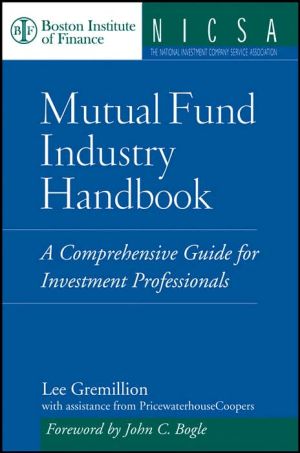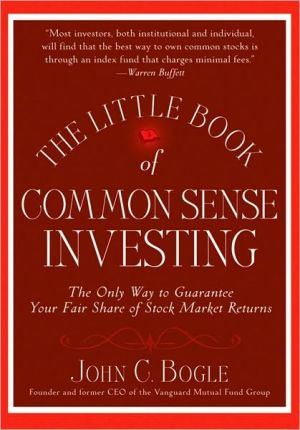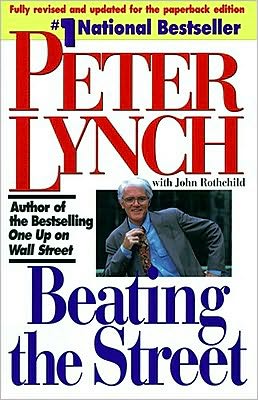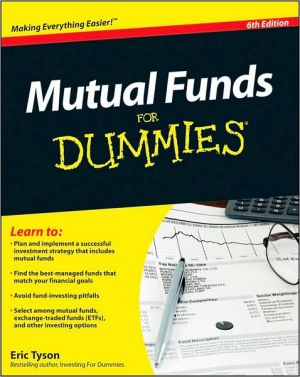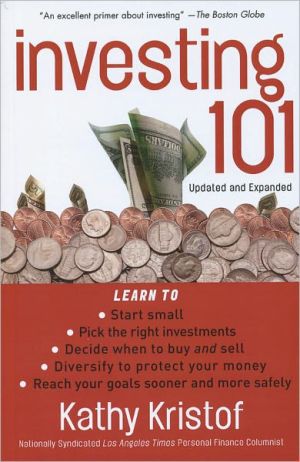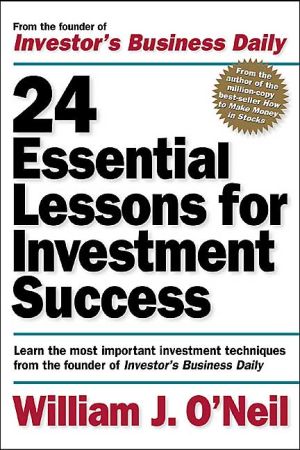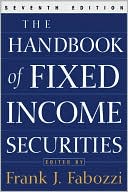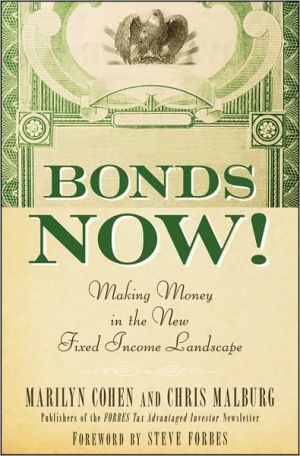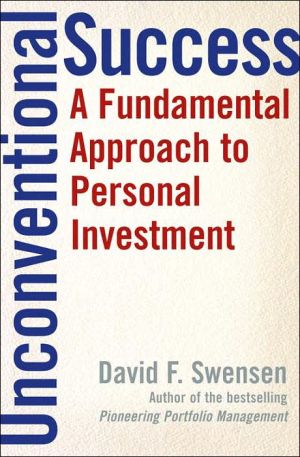Mutual Fund Industry Handbook: A Comprehensive Guide for Investment Professionals
Praise for the Mutual Fund Industry Handbook\ "The Mutual Fund Industry Handbook is a remarkably important work . . . I am profoundly impressed by the broad and comprehensive sweep of information and knowledge that this book makes available to industry participants, college and business school students, and anyone else with a serious interest in this industry."\ —From the Foreword by John C. Bogle President, Bogle Financial Markets Research Center Founder and former chief executive, The...
Search in google:
A behind-the-scenes look at the mutual fund industryWith more than 8,000 funds, more than $8 trillion in assets, and more than 87 million individual investors at the end of 2004, mutual funds—professionally managed pooled investment vehicles that give people the opportunity to participate in the securities market without having to become money managers—are very popular. This book focuses on open end funds, and gives you a comprehensive inside look at the mutual fund industry, including real-life examples of how specific functions are performed at various firms. You'll explore industry history and structure, investment management, portfolio operations, accounting, auditing, legal compliance, customer service, distribution, globalization, and e-commerce. You'll also learn about the cost of various mutual fund operations—both to the fund companies and to investors.?Mutual Fund Industry Handbook does not provide information about how to select mutual funds or delve into specific funds or categories of funds. Rather, it describes every facet of mutual fund operations in an accessible and easy-to- understand manner. It also objectively addresses controversial topics, such as the fees that funds charge investors, disclosure requirements, advertising, active versus passive management, responsibilities of fund directors, and recent scandals, including illegal late trading and market timing. Mutual Fund Industry Handbook concludes with a discussion of trends and conditions that can impact the industry. Whether you're an investment professional looking to improve your mutual fund knowledge or an investor who wants to understand what goes on behind the scenes throughout the mutual fund industry, this is the resource for you.
Mutual Fund Industry Handbook\ \ By Lee Gremillion \ John Wiley & Sons\ ISBN: 0-471-73624-4 \ \ \ Chapter One\ Introduction to the Industry \ In 1980, only one in 16 households invested in mutual funds; at the end of 2003, almost one of every two U.S. households is invested in mutual funds. More than a third of mutual fund assets are owned in accounts saving for retirement. -Investment Company Institute's 2004 Mutual Fund Fact Book\ Mutual Funds-Big Business by Any Standard\ Open any issue of the Wall Street Journal, or the business section of any major newspaper, and you will find several pages of densely packed print labeled "Mutual Funds." These pages may list the names, prices, yields, and other key attributes of over 8,000 funds, each representing an investment pool in which individuals or institutions can participate. At the end of 2003, there were more of these funds than there were common stocks on the New York or American Stock exchanges. Collectively, these 8,000 or so funds represented over $7.4 trillion dollars of assets, about 18 percent of the total financial assets of the U.S. population. At the start of 2004, 22 percent of U.S. retirement funds were invested in mutual funds.\ These funds give more than 90 million people the opportunity to participate in the securities markets without having to become money managers themselves. They are professionally managed, pooled investment vehicles. A mutual fund allows individuals (you, me,anyone with some money to invest) and institutions (corporations, foundations, pension funds) to pool smaller amounts of money into a larger amount for investment. Investment management professionals then manage this larger amount to allow\ investment strategies that would not otherwise be feasible (such as buying bonds that only sell in very large denominations);\ achieving economies of scale (such as paying low broker commissions) that are not attainable when investing smaller sums; and\ reduction of risk by holding a diversified basket of securities.\ As we will see below, mutual funds offer the investor a number of significant advantages compared to investing in individual securities.\ Because of these advantages, mutual funds have gained an increasing share of the nation's financial assets. During 2003, mutual funds received 26 percent of households' purchases of financial assets-that is, households put this money into mutual funds rather than bank savings, individual stocks, or other investments. These mutual funds purchases went into long-term funds. At the end of 2003, mutual funds reached their highest level of household financial assets at 18 percent, increasing from 10 percent ten years earlier. During these ten years, there was a securities markets boom in the late 1990s, and then a securities markets decline in 2001 and 2002. During 2003, the total assets invested in mutual funds grew from $6.4 to $7.4 trillion. The increase in mutual fund assets in 2003 rose from investment gains rather than cash flows because cash flows into long-term funds offset the cash flows from money market funds. Investment gains are dividends that shareholders reinvested in the funds, and the increase in value of the stocks, bonds, and other securities the funds held.\ To a large extent, the mutual fund industry is an American phenomenon. While mutual funds or similar investment vehicles exist in other countries, they are nowhere so popular as in the United States, although in recent years more worldwide investors are using funds as their investment of choice. At the end of 2003, the U.S. assets invested in mutual funds represented 57 percent of the worldwide total of open-end, pooled investment funds of nearly $14 trillion. France has the next largest mutual fund industry after the United States, with funds holding the equivalent of more than $1.1 trillion assets. Although the U.S. industry continues to have outstanding growth, increasing assets 34 percent between 1999 and 2003, worldwide total net assets grew 49 percent during the same five years. During the ten years from 1994 to 2003, the U.S industry's growth was 258 percent and the worldwide total net assets grew 236 percent.\ The mutual fund industry is a significant component of the U.S. financial services sector and receives significant attention from the U.S Congress, federal regulators, and states who want to protect the interests of U.S. households and their retirement savings. At the end of 2003, approximately $2.7 trillion of retirement savings were invested in mutual funds, representing 22 percent of retirement assets-excluding social security benefits that Americans will need in the future to pay for their retirements. In 2003, it was estimated that the 8,000 funds generated over $80 billion in revenue and provided employment for over a quarter of a million people, with fund management companies, investment advisers, custodial banks, distributors, transfer agents, and other third-party service providers. Collectively, U.S. mutual funds owned about 22 percent of the equity of publicly held U.S. corporations, about 5.1 percent of the debt securities issued by the U.S. Treasury and various federal agencies, and about 18 percent of the bonds issued by municipalities (states, cities, and counties). In the past few years, authors have penned over 100 books advising investors how to use mutual funds to help them meet their financial goals. A number of universities have recently established courses in mutual fund management.\ Mutual Fund Defined\ Before going any further, a few definitions are needed. All the funds listed in the "Mutual Funds" section of the newspaper fall into one particular category: they are open-end funds. Open-end funds are ones that will always sell new shares to investors wanting to invest money, or redeem shares from investors wanting their money back, at a price dependent on the net asset value (NAV) of the fund. (Well, almost always-there are exceptions, which we will describe as we go along.) In addition, each fund in the paper is registered with the Securities and Exchange Commission (SEC) pursuant to the Securities Act of 1933, and, therefore, is available for sale to the public. By and large, when someone says "mutual fund" in the United States today, this is what he or she is talking about-a registered open-end investment company.\ This book focuses on open-end funds. There are other types of funds and pooled investment vehicles, described briefly in the following paragraphs, but none approaches the stature of open-end funds in today's economy.\ Closed-end funds were more popular than open-end funds during the early years of the industry. Closed-end funds do not purchase and redeem shares at a price dependent on NAV. Instead, they collect a pool of money, issue shares once to the investors in exchange for their money, and normally plan to neither issue nor redeem these initial shares thereafter. The shares of a closed-end fund trade on the secondary market (such as the New York Stock Exchange), just as the common stock of a corporation does. The market determines the share price one gets when buying or selling the shares, and this price may be different from the net asset value.\ Today, closed-end funds have declined in popularity (for reasons discussed in the next chapter), to the point that their assets in 2004 represented just over three percent of those of open-end funds. We will not focus on closed-end funds in this book, except on occasion to contrast them with open-end funds.\ Unit investment trusts (UITs) resemble mutual funds, but the portfolio of securities of a UIT is fixed at inception and not actively managed. The sponsor of a UIT assembles a pool of money, purchases a basket of securities, and liquidates securities only in special cases (such as when a bond is called earlier than its maturity date). UITs are set up with a specified life span, after which they are liquidated, and many invest in debt securities. In general, holders of UIT shares purchase them to get a stable investment with a stated life span, although they usually can redeem their shares at any time at the current net asset value. At the end of 2003, Americans had UIT investments of less than $36 billion, a small fraction of the amount held in open end funds.\ Variable annuities (VAs) are contracts sold by insurance companies, which are often backed up by mutual fund investments. The investor pays a lump sum or makes periodic payments; the insurance company invests this money in a portfolio of securities, often mutual funds. The value of this invested money goes up or down as the prices of the underlying securities rise or fall. After a specified period of time, often when the purchaser reaches retirement age, the insurer starts paying the investor an annuity. The amount of these annuity payments (or, the lump sum amount the contract holder may elect to take) varies according to the performance of the underlying securities.\ The insurance contract allows the investor to defer the tax on the income earned from the investment until the money is withdrawn. This feature of VAs appeals to investors looking for ways to invest for retirement. On the other hand, variable annuities come with a cost-sales charges, administrative charges, and the mutual fund's expenses, or the costs required to manage the underlying investments when a mutual fund is not the investment of choice. The magnitude of these costs varies from one contract to another and from one insurance company to another. As of the end of 2003, Americans had about $866 billion invested in VAs for which the underlying securities were mutual funds.\ Hedge funds, another type of pooled vehicle, differ from mutual funds mainly because they are not aimed at the general public, but rather at the sophisticated and large investor. Hedge funds are private pools bound by contracts between the investors and the sponsors of the fund. In late 2004, the SEC, under the Investment Advisers Act, passed a new rule requiring hedge fund advisers to register. Typically, these funds require a minimum investment of $1 million or more, and typically pursue buy (long) and sell (short) investment strategies that may introduce more risk than do mutual funds that normally pursue only buy (long) strategies.\ Hedge funds represent just one variation on a much wider theme-the private investment pool. Many investment management organizations will pool assets from among their clients to achieve economies of scale. For example, banks often create collective trust funds into which they put the individual assets of trust customers, instead of attempting to manage each trust account separately. Insurance companies managing investments for other institutions (typically retirement plans), often do much the same thing. While these pools share some attributes with mutual funds, they are not offered to the general public, nor are they bound by the same regulations as are registered funds.\ Private investment pools vary endlessly. At the small and simple end of the range lie the investment clubs (like the famous Beardstown Ladies). At the other end we find such entities as limited partnerships, requiring investments of $1 million or more, formed to invest in arcane instruments or special economic sectors (like Long Term Capital Management, a hedge fund). Each has its place in the U.S. financial landscape, but none looms nearly so large in that landscape today as the mutual fund.\ Who Invests in Funds, and Why\ Who owns these trillions of dollars' worth of mutual funds? Individual U.S. citizens own the lion's share-77 percent at the end of 2003. Institutions of various sorts-bank trust departments, pension plans, corporations-own the remaining 23 percent. The Investment Company Institute (the ICI, described in Chapter 3) has published a profile of the average mutual fund investor in 2003, some of the attributes of which are shown in the following table. As the table suggests, the typical mutual fund investor is solidly entrenched in the American middle class.\ The growth in mutual fund assets over the past 20 years has been paralleled by the growth in the number of investors. In 2003, more than one in three American households owned one or more mutual funds. So why do so many Americans keep a large part of their investments in the form of mutual funds? Different investors will have different reasons, but the compelling ones include professional management, easy diversification, liquidity, convenience, a wide range of investment choices, and regulatory protection.\ Professional management. Mutual funds provide access to professional investment management for individuals who otherwise could not afford it. Trust departments of banks and private investment counsel firms have long offered professional management, but the minimum threshold for these services is typically $1 million or more in assets. Except in a few special cases, mutual funds require minimum investments in the $1,000 to $5,000 range, making them much more accessible.\ Diversification. In general, an investor reduces risk by investing in a larger number of securities, reducing the impact of a decline in value of any one of them. A mutual fund, with its large pool of assets, can economically hold a much larger portfolio of securities than any but the wealthiest individual investor could.\ Funds can hold a wider range of security types than individuals as well. Individual securities of some types cost tens or hundreds of thousands of dollars each to purchase, putting them out of the reach of most individuals, but not of mutual funds. Individual citizens find it difficult or impossible to purchase foreign securities, but can easily buy shares in mutual funds that hold foreign securities.\ Liquidity. Mutual funds must determine a net asset value (NAV) every business day, and redeem all shares offered for liquidation that day at that NAV. Shareholders are assured of being able to convert their holdings to cash whenever they want, through a well-defined and fair process (described in Chapter 7).\ Convenience. Mutual funds are easy to buy and sell, both directly from fund groups and through intermediaries such as brokers or fund supermarkets. They offer a wide range of attractive features for their shareholders, such as check writing, automatic purchase and redemption programs, and 24-hour access to information.\ Choice. An investor today can find a mutual fund to fit any investment goal he or she may have, from conservative to aggressive. In later chapters, we will see some of the types of mutual funds that provide this wide range of choices.\ Regulation. U.S. mutual funds are subject to regulation and oversight by the Securities and Exchange Commission (SEC). Each fund must provide each potential investor with a prospectus, a document that discloses its goals, fees and expenses, and investment strategies and risks. Funds must provide periodic reports showing the fund's actual investment performance and financial statements, including its statement of investments at a point in time.\ There's No Free Lunch, However\ Of course, the flip side of this coin is that investors pay for all these benefits. In 2003, they paid about two-thirds of one percent of the value of their fund assets for basic management services-investment management, administration, and the like. Some shareholders paid commissions to intermediaries as they purchased shares of the fund. Many funds paid commissions to brokers as they bought and sold securities, commissions that are paid from the shareholder's assets. The specific amount any one shareholder paid depended on the fund (where fees range from about 20 one-hundredths of a percent to almost two percent of assets), and the distribution method (zero for funds that have no sales commissions to several percent for some funds that do involve commissions). (Continues...)\ \ \ \ \ Excerpted from Mutual Fund Industry Handbook by Lee Gremillion Excerpted by permission.\ All rights reserved. No part of this excerpt may be reproduced or reprinted without permission in writing from the publisher.\ Excerpts are provided by Dial-A-Book Inc. solely for the personal use of visitors to this web site. \ \
Ch. 1Introduction to the industry1Ch. 2A brief history of mutual funds in the United States13Ch. 3Overview of industry structure35Ch. 4The mutual fund - product definition57Ch. 5The investment management front office83Ch. 6The investment management back office109Ch. 7Fund accounting, audit, legal, and other support functions131Ch. 8Fund distribution : the broker channel159Ch. 9The direct, bank, and institutional channels187Ch. 10Cross-channel issues : advertising and retirement investing207Ch. 11The transfer agent, part 1 - shareholder record keeping229Ch. 12The transfer agent, part 2 - customer service271Ch. 13Other service providers293Ch. 14Going abroad : open-end funds outside the United States307Ch. 15Going forward : issues and challenges329
